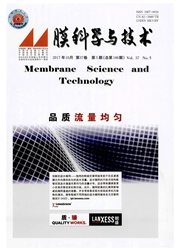

 中文摘要:
中文摘要:
提出一种利用浓差极化原理超滤浓缩生物大分子溶液的新型膜过程,即用自行设计的浓缩液汲取装置,抽提出浓差极化层内的浓溶液.以牛血清蛋白(BSA)为模型大分子,考查了汲取速率、透过通量对浓缩液浓度的影响,提出了动态平衡时浓缩液浓度的计算公式,并发展了一种可获得较高浓度浓缩液的周期性短时间歇汲取工艺,同时将新型膜浓缩过程与常规超滤浓缩进行了对比.结果表明,浓缩液浓度随汲取速率减小而增大,高通量不利于高浓度浓缩液的汲取;动态平衡时浓缩液浓度的计算值与测定值吻合良好;采用周期性短时间歇汲取工艺浓缩液浓度可达34.9g/L,为原料液浓度的69.8倍;与常规超滤浓缩相比,该浓缩过程膜污染显著减轻,可实现连续操作.
 英文摘要:
英文摘要:
A new membrane process was proposed to concentrate biological macromolecule solution by utilizing concentration polarization. With bovine serum albumin (BSA) as a model macromolecule, the BSA ultrafiltration was performed with total retentive membranes and the concentrated BSA solution in the polarization layer was drawn out by a purpose made dead - end ultrafiltration unit equipped with a self - designed drawing device. The effects of drawing rate, permeate flux on the concentration of concentrated solution (Cn) were studied; a theoretical model was proposed to calculate Cn when the process reaches a quasi - steady state; a periodic short- time intermittent drawing approach was developed, and the new process was compared with the conventional ultrafiltration concentration process. The results demonstrate that Cn increases with decreasing drawing rate, while high permeate flux would adversely affect the feasibility of obtaining high Cn. The calculated Cn values were in good agreement with the experimental data under quasi - steady conditions. With the intermittent short - time drawing approach, Cn was high up to 34.9 g/L and the concentration factor based on feed solution was 69.8. When the new process was adopted, membrane fouling could be significantly reduced, as a result, a continuous or semi- continuous operation could be highly applicable.
 同期刊论文项目
同期刊论文项目
 同项目期刊论文
同项目期刊论文
 期刊信息
期刊信息
